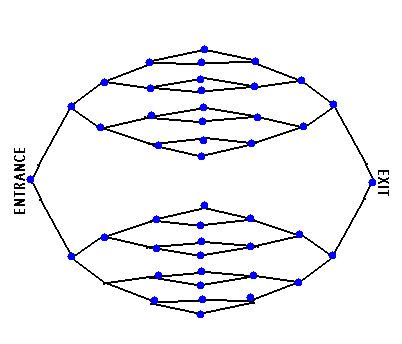 | ||
A Continuous-time quantum walk (CTQW) is a walk on a given connected graph that is dictated by a time-varying unitary matrix that relies on the Hamiltonian of the quantum system and the adjacency matrix. CTQW belongs to what is known as Quantum walks, which also consists of the Discrete-time quantum walk. The concept of Continuous-time quantum walk is believed to have been first considered for quantum computation by Edward Farhi and Sam Gutmann. Though, it may be possible to consider CTQW for directed graphs, we focus on this area as it applies to undirected graphs unless stated otherwise.
Contents
Introduction
Ever since the advent of quantum mechanics and the discovery by Shor of how to achieve factorization of large semi-primes efficiently (polynomial time) using quantum computation, scientists have been intrigued by the realm of possibilities. In many cases where the quantum algorithms are derived for problems, the complexity of the algorithms are faster than their classical counterpart. Some of these include Shor's factorization algorithm, which is exponentially faster than known classical factoring algorithms, and Grover's searching algorithms, which is polynomially faster than any possible black-box classical algorithm. Many of these algorithms use (or can be modified to use) the concept of quantum fourier transform.
In recent times, some scientists have decided to propose a new form of looking at quantum computation algorithms. The reason is that many classical algorithms are based on (classical) random walks. This led to the intuitive question of whether a "quantum random walk" (or simply "quantum walk") could be proposed. One such model of a quantum walk is the Continuous-time quantum walk (CTQW) proposed by E. Farhi et al. There are a number of variations to representing a CTQW, but we follow the definition below.
Mathematical definition
A continuous-time quantum walk (CTQW) on a graph G = (V,E), where V is the set of vertices (nodes) and E is the set of edges connecting the nodes, is defined as follows:
Let A be the |V|
and D be the |V|
where
Quantum walk
To discuss the quantum walk, it is useful to define the more familiar topic of (classical) random walk (CRW). The random walk is well-defined in random processes with the Markov process model.
Classical random walk (CRW)
Here, a graph is traversed in an order that predicts the probability of being at a node
Since John has a fair coin, the average of his distribution (where he's expected to be on the average) is the origin (position 0), and the standard deviation can be shown to be
Continuous-time quantum walk (CTQW)
Now, the fair coin in John's possession is replaced with a qubit. This qubit is defined in terms of states
and
After applying the Hadamard operator, the spin-1/2 rotation in the z-direction is applied, thereby stepping left or right based on the resulting state. Overall, the applied operator becomes
where
Difference between CTQW and CRW
Farhi et al. showed that on a symmetric graph known as
It could be deduced that the probability of reaching the EXIT node from the ENTRANCE node of a
It is also important to note that the quantum walk 'collapses' to a classical random walk with the degree of decoherence. It is possible to obtain the classical if one measures the positions in the quantum work at every step. In other words, the inability to have superposition restricts the classical domain of walks in graph theory.
Potential applications
The area of CTQW as well as discrete-time quantum walk has given additional insight on how to achieve quantum computation. It is an area of research that is still captivating interest and a number of algorithm using CTQW has been proposed. The three main applications to date are
- Quantum search algorithm
- Graph Traversal problem
- Quantum scattering NAND-tree
In each case, the algorithmic speedup is not different from what was expected in existing quantum algorithms like the Grover search algorithm that takes
